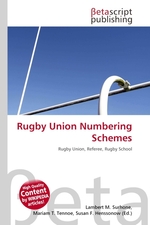Rugby Union Numbering Schemes
Lambert M. Surhone, Mariam T. Tennoe, Susan F. Henssonow
бумажная книга
High Quality Content by WIKIPEDIA articles! Noncommutative measure and integration refers to the theory of weights, states, and traces on von Neumann algebras (Takesaki 1979 v. 2 p. 141). If a von Neumann algebra acts on a Hilbert space containing a norm 1 vector v, then the functional a ? (av,v) is a normal state. This construction can be reversed to give an action on a Hilbert space from a normal state: this is the GNS construction for normal states. Any factor has a trace such that the trace of a non-zero projection is non-zero and the trace of a projection is infinite if and only if the projection is infinite. Such a trace is unique up to rescaling. For factors that are separable or finite, two projections are equivalent if and only if they have the same trace.
Данное издание не является оригинальным. Книга печатается по технологии принт-он-деманд после получения заказа.
High Quality Content by WIKIPEDIA articles! A rugby union team consists of 15 players plus up to seven replacements (depending on the competition). The starting players are normally numbered from 1 to 15 and the replacements 16 onwards. Traditionally, however, some clubs, notably Leicester Tigers and Bristol, used alternative schemes consisting of letters, whilst others Bath and Richmond used a scheme with no number 13. Leicester's numbers were from 1 to 15 corresponding A to O with the exception of the openside which who wore H which is the eighth letter of the alphabet. English Guinness Premiership sides have ceased using these numbers/letters to better aid the understanding of those new to the sport.
Данное издание не является оригинальным. Книга печатается по технологии принт-он-деманд после получения заказа.


